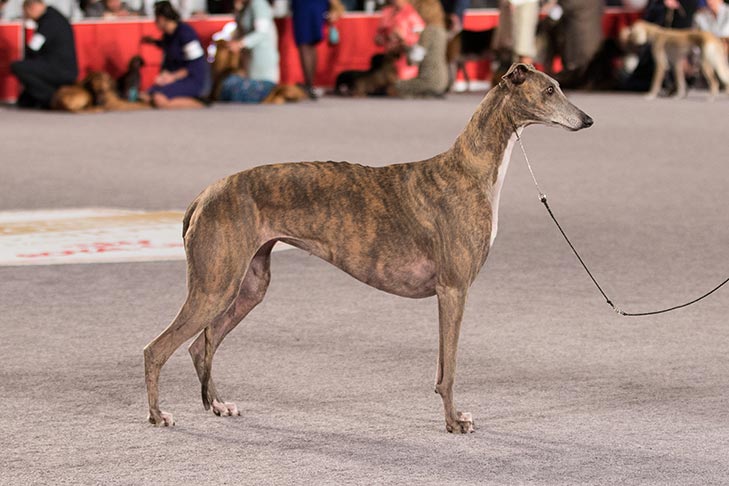Obesity in dogs is so common that owners may not recognize when their pet is overweight. Often, a healthy dog should be much leaner than many people think. But how do you know if your dog is too lean?
Maintaining your dog’s ideal weight and feeding them the appropriate nutrients and calories is essential to your dog’s health. We investigate how to know if your dog might be underweight and, if so, what you can do about it.
Is My Dog Underweight?
A dog who looks too thin is often actually in their ideal body condition. Dogs should have a defined waist when viewed from above and an abdomen that tucks up when viewed from the side. In addition, you should easily be able to feel a dog’s ribs when you run your hands down their sides. But can a dog’s waist be too defined, their abdomen too tucked, and their ribs too obvious? Absolutely.
It’s important to recognize when your dog is under their ideal weight, as that can indicate an improper diet or other problems. Dr. Jerry Klein, Chief Veterinarian for the AKC, points out that although dog obesity is a far more common concern than underweight dogs, “If a dog is underweight, it should be examined by a veterinarian to make sure there are no underlying medical issues.”

Signs Your Dog Is Underweight
So how can you assess your dog’s weight? First and foremost, consult your veterinarian. Because you see your dog every day, it’s easy to miss subtle changes in their weight, so seek out your vet’s professional eye. They are the expert on what your dog’s breed or mix of breeds should look like. Ask your vet for your dog’s body condition score and what you should watch for when monitoring their weight.
When it comes to underweight dogs, they tend to look gaunt or bony. According to Dr. Klein, in most breeds, the following signs indicate an underweight dog:
- Clearly visible ribs when the dog is viewed from the side (although seeing the hint of the last rib is not necessarily cause for concern)
- Multiple ribs clearly visible when the dog is viewed from above
- Overly prominent hip bones and visible bones at the top of the spinal column
Does a Dog’s Breed Affect Signs of Being Underweight?
The above signs are indicators of being underweight in most breeds, but not all. You can’t judge every breed the same way, as they can have different ideal shapes. Think of the body of a Bulldog versus a Saluki. Sighthounds like Salukis are naturally quite lean, and people often mistake them for being underweight. According to Dr. Klein, the morphology (how an organism is structured) of a Sighthound is different than, say, the morphology of a Rottweiler.

He adds, “Breeds bred along the prototype of Greyhounds are naturally lighter and leaner.” For example, pronounced hipbones are a desired breed characteristic in some ancient Sighthound breeds like the Afghan Hound or the Azawakh. Therefore, it’s important to consult your veterinarian or breeder to educate yourself about your own dog’s ideal body condition.
What Causes a Dog to Be Underweight?
There are many reasons a dog might be underweight. The most obvious is an insufficient diet. Dr. Klein says that a diet can have insufficient calories, meaning a dog isn’t receiving enough calories for their nutritional needs, or in the choice of food itself, meaning their diet is incomplete and unbalanced. Not all dog foods are created equally, just as not all dog foods contain the same quality of ingredients. Treats and table scraps can affect nutritional balance, as well.
Underlying medical issues can also affect a dog’s weight. For example, internal parasites like worms can cause weight loss. Dental problems, such as an abscessed tooth, can also make it painful for your dog to eat, which would reduce their caloric intake. Other health problems that can cause your dog to lose weight include metabolic diseases like diabetes, infectious diseases, and neoplasia (uncontrolled cell growth, which can result in a benign or malignant tumor).
How to Get an Underweight Dog to Gain Weight
If you suspect your dog is underweight, don’t just add more food to their bowl. Because there can be so many reasons for weight loss, it’s important to get your dog a full veterinary check-up first. Extra food won’t cure worms, for example. Depending on the cause of your dog’s weight loss, your veterinarian will guide you on a treatment plan.
If your vet determines a dietary issue is responsible, they might refer you to a veterinary nutritionist. It can be tempting to feed your dog high-calorie items like satin balls (raw hamburger meatballs) or butter-drenched chicken. However, speedy weight gain can be unhealthy for your dog. Certain high-calorie ingredients could also potentially be unhealthy or put your dog at risk for illnesses such as E. coli, listeria, salmonella, or pancreatitis. Your dog’s diet must contain a complete balance of nutrients. Follow your vet or nutritionist’s recommendations to ensure your dog is eating appropriately.

Dr. Klein suggests, “Depending on your veterinarian’s diagnosis and treatment plan, they may want you to gradually change your dog’s diet to a higher caloric diet or therapeutic formula or just increase the amount or number of times you’re feeding your current diet. It is imperative to always feed a well-balanced diet, as feeding too many supplements or table scraps can cause dietary imbalances or other medical conditions.”
If you come across a rescued dog that is extremely emaciated and starving, consult a vet immediately rather than simply feeding them. You want to avoid refeeding syndrome, which is when a malnourished animal is suddenly fed without properly managed nutrition. When a malnourished body without insufficient micronutrients (including vitamins and electrolytes) tries to deal with a sudden influx of food, the animal cannot properly metabolize, causing refeeding syndrome. Signs of refeeding syndrome in dogs can include respiratory or cardiac failure.

